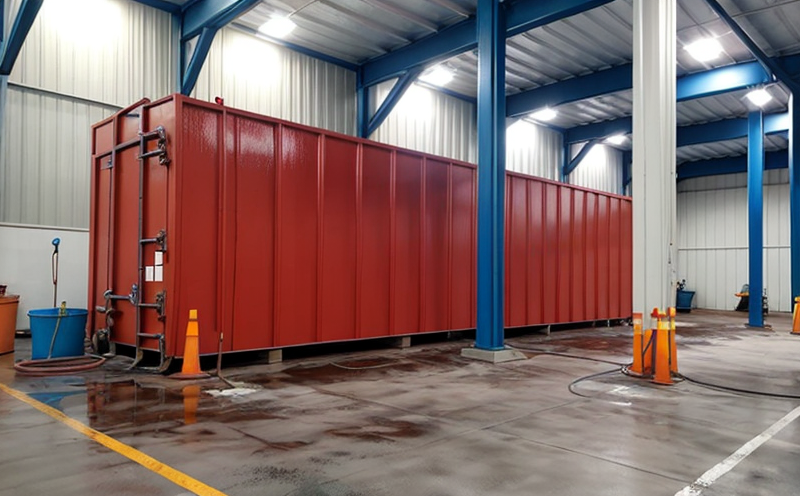ISO 16773 Electrochemical Impedance Corrosion Testing of Coatings
The ISO 16773 standard provides a robust method to evaluate the corrosion resistance and integrity of industrial coatings, paints, and other protective barriers. This testing is critical in industries where corrosive environments are prevalent, such as marine, petrochemical, and offshore manufacturing sectors.
The technique measures the impedance between two or more electrodes placed on the surface of a coating. By applying an alternating current (AC) voltage to the specimen, it assesses the ability of the coating to resist corrosion by analyzing the response across the entire frequency spectrum. This non-destructive approach allows for real-time assessment and provides valuable insights into the protective performance of coatings under various environmental conditions.
The test is particularly useful in identifying potential weaknesses or flaws that could lead to premature failure, ensuring that materials meet stringent quality standards before deployment. The method can be used on a variety of substrates including metals such as steel, aluminum, and alloys, as well as composite materials commonly found in industrial applications.
ISO 16773 testing helps manufacturers comply with regulatory requirements and industry best practices by providing reliable data that supports the development of long-lasting protective coatings. It also aids quality control processes to ensure product consistency and reliability across production batches.
The standard specifies detailed procedures for preparing specimens, applying the test method, and interpreting results. Compliance with ISO 16773 ensures that tests are conducted under controlled conditions, ensuring accurate and reproducible data. This is essential for maintaining high-quality standards in industrial manufacturing and processing environments.
| Test Parameters | Description |
|---|---|
| Frequency Range | From 1 kHz to 1 MHz, providing a comprehensive analysis of impedance behavior across different frequencies. |
| Electrode Configuration | Dual-electrode setup for accurate measurement and comparison with reference specimens. |
| Solution Environment | Potassium chloride (KCl) solution at a specific concentration to simulate real-world corrosive conditions. |
| Data Analysis | Fourier Transform of the impedance data for frequency domain analysis and interpretation. |
The procedure involves several steps, starting with proper specimen preparation. This includes cleaning and conditioning the surface to ensure accurate measurement. Electrodes are then applied according to standardized procedures, followed by the application of AC voltage across the electrodes. The system records the impedance response at various frequencies.
Interpreting the results requires careful analysis of the data obtained from the test. Engineers use specialized software tools to plot and analyze the frequency domain curves, which help in identifying the protective properties of the coating. This information is invaluable for optimizing coating formulations and enhancing their resistance to corrosion.
Industry Applications
- Marine structures: Ensuring coatings withstand saltwater environments.
- Petrochemical plants: Evaluating coatings in highly corrosive hydrocarbon atmospheres.
- Offshore platforms: Testing the integrity of protective layers in harsh marine conditions.
- Automotive manufacturing: Assessing surface protection against acidic rain and industrial pollutants.
The ISO 16773 method is widely used across these sectors, providing critical data to enhance product performance and reliability. By identifying potential weaknesses early in the development process, manufacturers can implement corrective measures before production begins, ensuring compliance with international standards and industry best practices.
| Environmental Conditions | Description |
|---|---|
| Salt spray test chambers | Simulate marine environments for long-term durability testing. |
| Ambient temperature and humidity controls | Reproduce real-world conditions in controlled laboratory settings. |
| High-pressure water jets | Evaluate coating resistance to physical abrasion and impact. |
The method is also beneficial for quality assurance programs, where it helps in ensuring that coatings meet specified performance levels. By adhering to the ISO 16773 standard, manufacturers can demonstrate their commitment to high-quality products and sustainable manufacturing practices.
Customer Impact and Satisfaction
The implementation of ISO 16773 testing has a significant positive impact on customer satisfaction. By providing reliable data that supports the development of long-lasting protective coatings, customers can trust in the durability and performance of products. This enhances brand reputation and fosters loyalty among clients.
Manufacturers benefit from reduced warranty claims as they can ensure compliance with quality standards before products reach the market. The method also aids in optimizing coating formulations to better withstand specific environmental challenges, leading to longer product lifecycles and increased customer satisfaction.
The testing process itself is efficient, providing quick turnaround times for results. This allows companies to make informed decisions promptly, reducing development cycles and minimizing costs associated with rework or redesigns. Additionally, the standardized approach ensures consistency across different batches of products, further enhancing reliability and trustworthiness in the eyes of customers.
ISO 16773 testing is an essential tool for maintaining high-quality standards in industrial manufacturing and processing environments. By adhering to this method, companies can ensure that their products meet stringent quality requirements and industry best practices, ultimately contributing to customer satisfaction and loyalty.
Environmental and Sustainability Contributions
The ISO 16773 standard plays a crucial role in promoting sustainability by ensuring the longevity of industrial coatings. Long-lasting protective layers reduce the frequency of maintenance and replacement, leading to significant resource savings over time. This minimizes waste generation and reduces the environmental footprint associated with frequent reapplication or renewal of coatings.
- Reduces material usage
- Promotes energy efficiency by enhancing coating durability
- Minimizes lifecycle costs for industrial facilities
- Supports compliance with environmental regulations
By identifying and addressing potential weaknesses early in the product development cycle, ISO 16773 testing helps manufacturers design more sustainable products. This approach not only benefits the environment but also contributes to a more efficient use of resources and reduced operational costs for industrial facilities.





